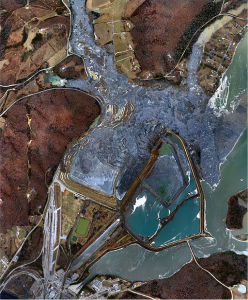Coal ash has been in the news quite a bit this year, and it’s a topic we follow closely because we consulted on some of the lawsuits included in the class action litigation regarding the December 2008 Tennessee Valley Authority (TVA) Kingston fly ash spill, the largest coal ash spill in U.S. history. On August 1, 2014, TVA agreed to pay $27.8 million to settle claims from property owners who suffered damages due to the 2008 spill. On August 5, U.S. District Judge Thomas Varlan approved the settlement.
TVA has been using coal to make electricity for the Tennessee Valley region since the 1950s. One of its 11 coal-fired power plants is the Kingston Fossil Plant, located on Watts Bar Lake in Harriman, Tennessee, near Kingston. The ash ponds at the Kingston plant were separated from a nearby river only by earthen dikes, not stored in lined landfills. On December 22, 2008, a retention pond dike at the Kingston plant failed, creating a tidal wave of water and ash that destroyed several homes and ruptured a major gas line in a neighborhood adjacent to the plant. An estimated 5.4 million cubic yards of coal ash sludge spilled into the Emory and Clinch Rivers and onto surrounding property. Our firm got involved in the matter in 2009.
Altogether, 63 lawsuits involving more than 850 plaintiffs asserting claims of negligence, trespass, and private nuisance against TVA arising from the 2008 ash spill had been pending in the U.S. District Court in Knoxville. The settlement, known as a mediated global resolution, was announced after nearly 2 years of mediation ordered by Judge Varlan after he ruled in 2012 that TVA was liable for the spill. Now that the settlement has been approved, the legal battle ends after more than 5 years.
U.S. Environmental Protection Agency (EPA) Administrator Lisa Jackson described the spill as “one of the largest and most serious environmental releases in our history.” During the time-critical cleanup phase, over 3.5 million cubic yards of coal ash were removed from the Emory River in just 12 months. At least 500,000 cubic yards of coal ash are estimated to remain on the bottoms of the Emory and Clinch Rivers, where natural sediments are being allowed to dilute and cap the residual fly ash deposits in a process referred to as monitored natural recovery. Other cleanup efforts continue, with total costs expected to exceed $1.2 billion.
The TVA Board of Directors has stated that “Bringing this matter to a close is a significant milestone for all involved. TVA remains committed to completing the Kingston recovery project and restoring the community to as good as or better than it was before the spill. The restoration project is scheduled to be completed in 2015.”






I have restpertiory problems from the Cole ash spill,l was there 5years from the beginning when we had to swim in it to place pumps in,and then set on haul rds. To flag trucks in all that dust. I worked with Roberta hall,who is dead, Lenard Copeland,who is dead, David Dugger, and many more. I was one of the first team members sent there Dec 23 2008. I need help and can’t get anybody to hear me.